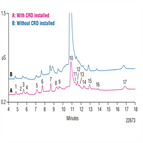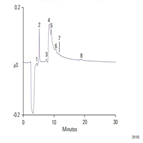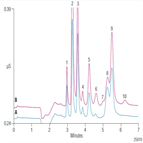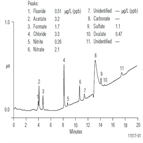Find methods for your needs
Refine by Feature
Displaying 1-4 of 4 results for Tag: pure water
TN62: Reducing Carbonate Interference in Anion Determinations with the Carbonate Removal Device (CRD): Trace Anions
Instrument Type: ICCarbonate can interfere with accurate quantification of adjoining anions, such as sulfate. Here we show the efficient removal of the carbonate peak from a trace analysis water sample using the Dionex CRD 200 device. In this example, a large volume (1000 uL) of water spiked with < 4 ug/L concentration of 17 anions is directly analyzed.
TN113: Practical Guidance for Using Capillary Anion Chromatography - Concentrate Mode
Instrument Type: ICConfiguring a capillary IC system for trace analysis is discussed in this technical note, TN113. Tips and tricks for trace anion analysis for ion chromatography (IC) systems and capillary IC systems are discussed. Data is also shown for concentrating and direct injection of a large volume injection. This example demonstrates anion determinations by concentrating 200 uL of sample.
AN222: Determination of Parts-Per-Trillion Concentrations of Strontium by Pre-Concentration with Ion Chromatography and Suppressed Conductivity Detection
Instrument Type: ICRadioactive isotopes of strontium (90Sr and 89Sr isotopes) are byproducts of nuclear power plant reactions. 90Sr monitoring is needed because 90Sr can displace calcium in bones and teeth, resulting in long term exposure and subsequent increased cancer risk. Ion-exchange chromatography can be used to focus and isolate 90Sr from other isotopes that interfere with accurate scintillation determinations. Here ng/L of non-radioactive Sr as a retention time marker for 90Sr is pre-concentrated, then separated on an IonPac CS12A column, and detected by suppressed conductivity.
AN113: Determination of Trace Anions in High Purity Waters by High Volume/Direct Injection Ion Chromatography
Instrument Type: ICTrace anion determinations are important to the power and the electronics industries. The Electric Power Research Institute (EPRI) recommends using IC to determine concentrations down to 0.25 µg/L, whereas the Semiconductor Equipment and Materials International (SEMI) recommend IC for contaminants from 0.025 to 0.5 µg/L. This application note describes the use of a gradient separation using the IonPac AS11 column for the determination of trace anions by high volume/direct injection. This method is applicable to pure water samples and high-purity waters containing corrosion inhibitors.




